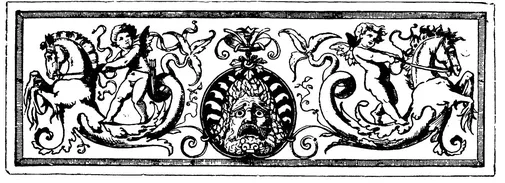![]()
CHAPTER I.
INTRODUCTION.
THE Art of Fencing, in Europe, has seen four distinct periods, during which it has been influenced partly by the forms of the weapons, and partly, for the arms themselves were so influenced, by the changing fashions in dress. We find first the Shakespearian or Tudor era—that of the sixteenth century—when owing to the prevailing style of costume, and to the fact that the swords were long and unwieldy, they were almost always accompanied by an arm either purely defensive, like the buckler or the cloak, or by one, such as the dagger, of a character at once defensive and offensive ; these auxiliary arms were carried in the left hand, and their movements were extremely simple.
The second period, and perhaps the most interesting of them all, that of the Stuarts, was a period of transition; the dagger had passed out of fashion as an article of dress, and in Western Europe the long, handsome rapier had by degrees given place to the short walking sword, which, however, did not assume a settled form until the century following; but the Italians, who were the original teachers of our art, adhered to the earlier form. This change of pattern in the sword necessitated a change in the method of using it, and hence arose the two great and only “schools” of fence, the Italian and the French.
From this point we deal with the French system alone, and we find that as the short, light swords improved in their form, the art of wielding them advanced in precision and grace, which latter quality may be said to have attained its perfection about the middle of the eighteenth century, at the time, in fact, when the first of the Angelos brought out his famous folio. In the works of this period there is a very noticeable feature in the numerous tricks which the masters taught their pupils for depriving an enemy of his sword. In this our modern time disarming is not usually allowed, and it is always considered very rough play; but in the days of which we speak the sword was an integral part of every gentleman’s dress, and a facility in disarming no doubt saved many a life in the sudden quarrels in street or tavern which were then matters of every-day occurrence.
About the middle of the last century wire fencing masks were introduced, but there was a feeling against them on the part of the masters, and it was some considerable time before they came into general use ; previous to their adoption a fencing bout bore a somewhat stately and academic aspect—the movements were slow, and it was a matter of etiquette not to riposte until after the adversary had recovered from his lunge, for fear of injuring his face. All this, however, was altered about the beginning of this century, when the attitude of the masters towards the mask was changed by a serious accident which happened to one of them, and under the auspices of such men as Jean Louis, Gomard, Cordelois, and others, not to mention many famous teachers of the present day, the art of point-fencing has attained its climax.
![]()
CHAPTER II.
THE TWO-HAND SWORD.
THIS weapon, sometimes known as the old English “long sword,” as a fighting arm stands by itself; it was the favourite weapon of our King Henry VIII. in his athletic days, and he proposed its use in the tournaments at the “Field of the Cloth of Gold,” but Francis I. objected to it on the ground that there were no gauntlets then made sufficiently strong to guarantee the hands against its powerful strokes.
The following lessons have been compiled from the works of Marozzo (1536), Di Grassi (1570), Joachim Meyer (1570), Jacob Sutor (1612), and Alfieri (1653). The method of handling the weapon is very similar to the exercises of the “Great Stick,” introduced in 1889 in “Cold Steel,” and adapted from Italian sources ; in fact, these latter are a distinct survival of the two-hand sword-play of the sixteenth century. The best manner of carrying the two-hander is taken from Alfieri (Plate 1). It is borne point upwards in the left hand, which grasps the grip about the centre, with the flat of the blade resting against the shoulder; it must be remembered that this sword is double edged.
TO SALUTE.
1. Pass the right hand across the body and seize the grip close to the quillons.
2. Bring the sword perpendicularly in front of the body with the quillons in line with the mouth.
3. Carry the sword over to the right side, and lower the point to the front about four inches from the ground, and draw back the right foot about six inches.
4. Raise the sword to a perpendicular position at the right side.
5. Carry the sword over to the left side, and resume the marching position.
GUARDS.
The favourite engaging guard of Marozzo was his guardia di testa, as seen in the illustration (Plate 2). Alfieri also makes use of one very similar. The guards in quarte—porta di ferro alta—(Plate 3), and tierce—coda lunga e stretta— (Plate 4), may also be used.
THE CUTS.
There are six principal cuts : two oblique downwards at the sides of the head or the shoulders, two oblique upwards, and two horizontal cuts, made usually at the flank. Those delivered at the left side of the enemy were called mandritti, and those at his right side riversi ; the former were given with the right foot, and the latter with the left foot in advance.
THE MOULINETS.
The six moulinets are absolutely necessary for the acquirement of dexterity in wiel...


